Creggannacourty
Houses within 10km of this house
Displaying 55 houses.
Houses within 10km of Creggannacourty
Displaying 55 houses.
| House name | Description | |
|---|---|---|
| Ballygiblin | This was the seat of the Becher baronets in the 19th century. Occupied in 1814 by Beecher Wrixon and in 1837 recorded by Lewis as "recently modernised" [William Morrison]. Sir William W. Beecher held Ballygiblin in fee at the time of Griffith's Valuation when it was valued at £52. The seat of Sir John Wrixon Becher in 1894 and still occupied by the Bechers in 1906. In 1944 the Irish Tourist Association Survey reported that it was owned by D.CMurphy and J. Lombard. The report contains detailed background to the Beecher family including the story of Lady Beecher, the actress, Elizabeth O'Neill. This house is now a ruin. |
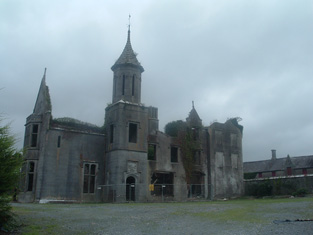
|
| Churchtown House | Located on the Egmont estate Churchtown House was the residence of the Crofts family in the 18th and early 19th centuries. Occupied by George Crofts in 1814 and by the Reverend F.W. Crofts in 1837. By the time of Griffith's Valuation it was owned by Sir Edward Tierney in fee and valued at £44. Later 19th century occupants were Major Trench and John Cowhey. This house is still extant and occupied. |

|
| Ballyphilibeen | A building is marked on the first Ordnance Survey map in this townland. By the time of Griffith's Valuation Prudence Twinhan was living in a house valued at £14 and held from Thomas Wise with 225 acres. | |
| Castlecor | The home of the Freeman family purchased from the Chinnerys in the early 18th century. Smith records it as the seat of William Freeman in 1750 and Wilson describes it as "the fine seat of Mr.Freeman" in 1786. Later the home of the Deane Freeman family who enlarged the building at the beginning of the 19th century. Advertised for sale in 1852, Bence Jones writes that it was bought by Richard Barry. It remained in the Barrys' possession until the 1950s. In the 1940s the Irish Tourist Association survey noted that "the house and offices are now rather neglected". Sold by Mr Hope Murray in the 1960s and subsequently demolished. | |
| Lackeel | An early 19th century house valued at £12 was held by Charles Daly in the mid 19th century from Pierce Purcell. This house is still extant. |
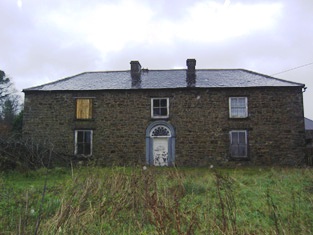
|
| Marybrook | This was originally a tower house with additions from the mid 18th century. Occupied by Edward H. Reardon in the first half of the 19th century and by John O'Connell in the mid 19th century, when it was valued at £11 and held from Bartholomew Gibbings. In the sale rental of May 1860 this house was describes as in "thorough repair" and leased to John Connell for 100 years from 1851. In the 1940s the Irish Tourist Association Survey reported that it was then the residence of the Cronin family. It is still extant and in use. |
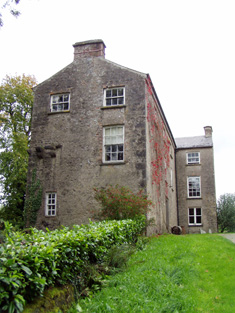
|
| Subulter | Leased at the end of the 18th century to James Leahy by the Lloyds. Occupied by John Leahy in 1837 and by Richard Leahy in the early 1850s who held the house valued at £18+ from Thomas Lloyd. Later owned by the Warrens of Codrum House. A new house now stands on the site. | |
| Cecilstown Lodge | A home of members of the Wrixon family in the late 18th and early 19th centuries. Occupied by William Wrixon, father of Sir William Wrixon Becher, in 1837. It was leased to Thomas Heffernan from the 1840s. Valued at £9 in the early 1850s it was later occupied by members of the clergy including the Reverend E.G. Jones, whose widow bought the house in the early 20th century. It was burnt in June 1921 during the War of Independence when it was the residence of the sisters, Esther Jane and Annie Jones. A house, however, still exists at the site. | |
| Dunbarry | This house was the home of James Carey in 1814. Occupied by James Heffernan and held from Sir Edward Tierney at the time of Griffith's Valuation, valued at £18. Sold by the Heffernans in the early 20th century, this house is still extant. The Irish Tourist Association survey mentions Dunbarry as the residence of Denis Kiely in the 1940s. | |
| Tullig | Tullig, located on the Tierney estate and valued at £15.15 shillings, was occupied by Richard Hutch in the early 1850s. The Irish Tourist Association Survey noted that it had belonged to Lord Broghill before the 1641 rebellion and was later granted to the Percevals. It was the residence of John Waterson in the 1940s. It is no longer occupied. |

|
| Gubleagh House | The buildings at Gubleagh House, Annagh South were valued at £13 at the time of Griffith's Valuation and the house was occupied by Johanna Cowhy who held it and 189 acres from Sir Edward Tierney. This house is still occupied. | |
| Burton Park | The original house built by Sir John Perceval and his descendants was burnt down in the Jacobite War 1689-1691. A late Georgian house was built to replace it by the [3rd or 4th] Earl of Egmont which was remodelled in the late 19th century. Burton Park was leased to the Purcells in the 19th century. It was occupied by the Reverend Matthew Purcell in 1814 and 1837 and by his son John in the early 1850s when the house was valued at £34. Passed to the Ryans of Scarteen, county Limerick by marriage in the early 20th century. In the 1940s the Irish Tourist Association Survey noted Burton Park as one of the best examples of eighteenth century domestic architecture in county Cork. Still the home of the Ryan Purcell family. |

|
| Clashganniv | Hajba writes that this house has always been the home of the O'Brien family. Vincent O'Brien, the famous Irish race horse trainer, was born at Clashganniv in 1917. The house is still extant and occupied. At the time of Griffith's Valuation there were two houses in Clashganniv, one valued at £16, was occupied by James Lynch and the other valued at £10 was held in fee by Sir Edward Tierney. | |
| Mount Corbitt | Home of the Glover family in the first half of the 19th century. Hajba writes that the Glover's sold their lease to the Anderson family in the early 1850s. In the early 20th century it became the home of the O'Brien family and is still occupied. |

|
| Rath | Smith writes in 1750 that Rath was built by Alderman James French of Cork. Rath house was occupied by Michael Greene in the early 1850s and held from Sir Edward Tierney. It was valued at £12. To the north Rath Cottage (Grid Ref R492 147) was held by Sir Edward Tierney in fee and was valued at £14. This cottage is now a ruin and Rath House although still extant is no longer lived in, a new house having been built on the site. | |
| Walshestown | This townland was leased to Robert Conron early in the 18th century by Sir Philip Perceval. By 1814 the house was occupied by John Wrixon. Hajba writes that he was the son of Edward and Anne Wrixon. In the early 1850s Nicholas Wrixon was resident holding the house valued at £8 from John Wrixon. In the 1830s the house is recorded as being occupied by George Crofts and his wife Eliza Purcell of nearby Burton Park. George Crofts was a brother of the Reverend F.W. Crofts. This house is no longer occupied. |

|
| Jordanstown | A house valued at £14 was occupied at Jordanstown by James Buckley at the time of Griffith's Valuation and held from Sir Edward Tierney. Hajba writes that the Buckleys continued to live at Jordanstown for the rest of the 19th century. Sold to Patrick Walshe in the early 20th century this house is no longer occupied. |

|
| Liskelly | This house situated on the Egmont estate was occupied by Richard Gregg in 1814 and in the early 1850s by David Coghlan who held the house valued at £12 from Sir Edward Tierney. Later Liskelly became the residence of the Nagles and the Brownes. It is no longer occupied. | |
| Bregoge House | A house reputed to incorporate the remains of an old castle. Bregoge Castle was occupied by J. Rogers in 1837 and by John Rogers in the early 1850s. The property was held from the Earl of Egmont and the buildings were valued at £7. The Irish Tourist Association survey in the 1940s notes it as the residence of "Mr.Ryan, a commercial traveller". The house is still a family home. |

|
| Glenville | At the time of Griffith's Valuation Mary Allen occupied Glenvillle, a house valued then at £8. The property was held from the Earl of Egmont. Catherine Cooke daughter of William Allen of Glenville married John Bevan of Camas in 1856. Hajba writes that Glenville belonged to Massy Bevan in the late 19th century. The house was restored in the 20th century and is occupied. |

|
| Rathclare | Clare Cottage was originally a residence on the Egmont estate which Hajba writes was leased to the Norcott family. Occupied by Martha Bullen in the early 1850s when the house was valued at £13. A much larger house was constructed in the mid 19th century incorporating the original building. By the end of the 19th century the home of the Burdon family who were still resident in 2002. In 2012 it was being offered for sale. |

|
| Ardenville | A single storey house possibly built for the heir to the Egmont title, Baron Arden, to reside in before succeeding to the title. At the time of Griffith's Valuation it was occupied by James Norcott and valued at £11.10 shillings. Recently extended and still occupied. | |
| Spitalfields | Dating from the mid 18th century, Hajba writes that this house was built by Christopher Waggett, nephew and son-in-law of George Crofts of Velvetstown House. By 1814 it was occupied by Richard Purcell and at the time of Griffith's Valuation by Fitzgerald O'Keeffe who held it from the Earl of Egmont. It was valued at £20+ at this time. In the 1870s George Crofts Harris of Spittalfields owned 591 acres in county Cork. The property of the O'Brien family in the 20th century, run as a guest house. |

|
| Egmont House | An early Perceval house situated at Egmont was replaced by the present house in the 18th century. At the time of Griffith's Valuation John Bolster was occupying Egmont House on the Egmont estate. The buildings were valued at £15. Later leased to the Lynch family. The house is extant and under refurbishment in recent years. |

|
| Egmont Lodge | A house was in existence at this location at the time of the first Ordnance Survey but is not named on the map. By the time of Griffith's Valuation it was valued at £14 and occupied by Bartholomew W. Purdon. It is labelled Egmont Lodge on the 25-inch Ordnance Survey map of the 1890s. A house is still extant at the site. |

|
| Egmont Cottage | Egmont Cottage is marked on the first Ordnance Survey map circa 1840. It was the single storied residence of Margaret Magrath in the early 1850s. She held the property from the Earl of Egmont and the buildings were valued at £10. The building has since been extended and is still occupied. Hajba calls this house Egmont Lodge. |

|
| Fort Moylan | Home of the Moylan family on the Egmont estate, occupied by Cornelius Moylan at the time of Griffith's Valuation when the buildings were valued at £10. Still extant and occupied |

|
| Buttevant Castle | Originally a castle of the Barry family, Earls of Barrymore, sold by them in the early 19th century to John Anderson of Fermoy, who restored it as a castellated house and gave it to his eldest son Sir James Anderson. Sir James lived there until the mid 1840s. William Roche occupied the building valued at £37 in the early 1850s. He held the property from Viscount Doneraile and D.R. Browning held a house, flour mill and offices valued at £120 from Roche. The castle had various occupants in the later 19th century and was last occupied in the early 20th century. It is now a ruin. |

|
| Castle View | Located on the Doneraile estate in the mid 19th century this house was occupied by Barry Gregg in 1837 and by the Reverend Cornelius Burkley in the early 1850s when it was valued at £28. This 18th century seven bay house is still a family residence. |
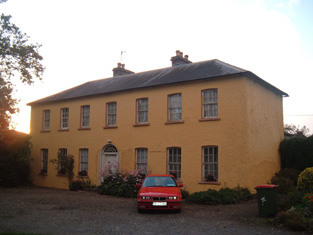
|
| Springfield | The seat of the Norcott family in the 18th and 19th centuries, occupied by Hugh Norcott in 1814 and by James Norcott at the time of Griffith's Valuation when the buildings were valued at £18. The property was held from the Viscount Doneraile at this time. Sold to the Davisons in 1908, it remained in their possession for much of the 20th century. The house is still occupied. |

|
| Velvetstown | Seat of the Crofts family for over three centuries, "Velvex-town" was occupied by Thomas Crofts in 1814, by T. Lucas Crofts in 1837 and by Reverend William Crofts in the early 1850s. Reverend William held the house and 708 acres from Penrose Fitzgerald and the buildings were valued at £21. Hajba writes that the original house was replaced by an elaborate Italianate mansion in the late 1870s but when this burnt down in 1895 they moved back into their old home. She also writes that Velvetstown is one of the few North Cork houses still occupied by the family that built it. The Irish Tourist Association survey noted in the 1940s that the walls of the Italianate mansion were still standing though the chimneys had been taken down. |

|
| Castle Wrixon | A Wrixon property in the 18th century, occupied by John Wrixon in 1814 and Hajba writes that it was sold by the Wrixons to the Crofts in the mid 19th century. At the time of Griffith's Valuation it was occupied by John Connor who held it from Wills G. Crofts. The buildings were valued at £11. Christopher Crofts of Velvetstown House (died 1913) lived at Castle Wrixon for a time. He inherited Velvetstown from his uncle, Reverend Henry, in 1869. In the 1940s the Irish Tourist Association Survey outlined subsequent owners and noted that it was, by then, the residence of the McDermott family. It is still extant. |
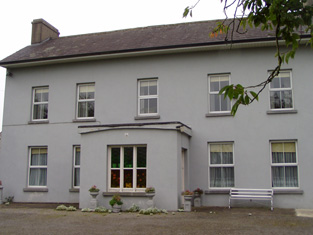
|
| Templemary | A house located on the Purcell estate, occupied by Purcell esq in the 1770s and 1780s, by John Purcell in 1814, by J. O'Leary in 1837 and by Kilner R. Woods in the early 1850s who held it from Wills George Crofts. The house was valued at £23+ at this time. The Fuges occupied the house in the late 19th century and early 20th century. The house was valued at £26 in 1906. The Irish Tourist Association survey in the 1940s described it as "a spacious three-storey house with a cellar". A new house now stands on the site. | |
| Baily Ville | Situated on the Neville estate this house was built by the Baily family in the mid 19th century. It is marked on the first Ordnance Survey map, circa 1840. By the 1870s Richard Gregg was living in the house which was then known as Oakville. He owned 405 acres in county Cork. Hajba writes that Gregg sold his interest in the property to the Fitzpatricks in the 1880s and this family was still in residence in the early 21st century. | |
| Cooliney House | Hajba writes that Cooliney was originally part of the Bowerman estate and that the house was rebuilt in the mid 18th century. It passed through marriage to the Nevilles of Furnass, county Kildare. Occupied by Mr Thomas Weldon in 1814 and by R. Weldon in 1837. At the time of Griffith's Valuation Robert Weldon held the house and 85 acres from James Hill. The house was valued at £20. In the 1940s the Irish Tourist Association survey noted that it was then the home of the Goold family. The house was restored in the 21st century. |
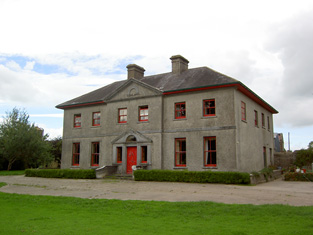
|
| Currymount | Lewis gives J. O'Leary as the proprietor of Currymount in 1837. By the time of Griffith's Valuation Currymount was held by Alexander McCarthy in fee and was valued at £7.10 shillings. Hajba writes that Alexander McCarthy left Currymount to his brother-in-law, James Morrogh, third son of James Morrogh of the city of Cork. The house was considerably extended post Griffith's Valuation. James McCarthy of Currymount owned 259 acres in the 1870s. In the late 19th century Eustace Morrogh Bernard lived at Curraghmore. Bought by the Purcells of Burton Park in the second decade of the 20th century as a dower house and passed by marriage to the Bird family. The Irish Tourist Association Survey refers to it as the seat of Major Bird in the 1940s and also that the Morrogh-Bernard family resided here before going to live at Byblox. |

|
| Milltown Castle | Originally the home of Thomas Evans, a younger brother of the 1st Baron Carbery, and of his son Eyre Evans. Mary, sister of Eyre Evans, married George Bruce in the mid 18th century. The Castle was subsequently leased by the Evans to the Bruces and it remained the home of the Bruces until the late 19th century. Described by Lewis as “a handsome castellated mansion in the later English style”. Reduced in size in the early 20th century. The Irish Tourist Association Survey of the 1940s noted that the buildings, at that time the residence of the Keane family, were not in good repair. However, the building continues to be occupied. |
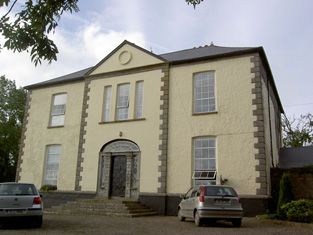
|
| Fortwilliam | A house on the Evans estate occupied by William Barry at the time of Griffith's Valuation when it was valued at £23, later a Sheehy residence. The Sheehy sale rental of 1875 records the house containing 3 reception rooms and 5 bedrooms. It was conveyed to Robert K. Sheehy by Edward R. C. Barry on 7 January 1874 and advertised for sale in June 1875. The National Inventory of Architectural Heritage dates this Tudor Revival house from circa 1880 to the design of Sir John Jackson (1851-1919), so the present house may incorporate the earlier one which is marked on the first Ordnance Survey map. In 2006 this house was no longer occupied. |
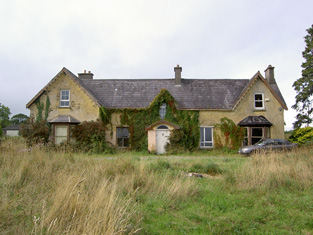
|
| Prohust | Prohust/Prohurst/Proughis was built by Jonathon Bruce, third son of the Reverend Jonathon Bruce of Milltown Castle, and occupied by him in 1837. By the time of Griffith's Valuation the property was held by George and John Evans in fee, the buildings were valued at £37. Hajba writes that the house was occupied by members of the Turner and Rice families in the latter half of the 19th century. This house is still occupied. |
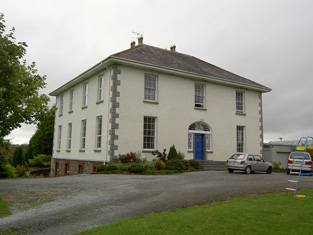
|
| Gibbings Grove | This house was the seat of the Gibbings family in the 18th and early 19th centuries. The family was still resident in 1837 but by the early 1850s the house was occupied by Edmond Irwin who held it form Richard Gibbons. It was valued at £14. Later occupants were local priests and it was eventually sold by the Gibbings in the late 19th century. In 1944 the Irish Tourist Association Survey referred to it as the home of the Cagney family who had purchased the property c.1912 and also that it was famous for growing the Toormore apple, used in making cider. The house is still occupied. |

|
| Altamira | Originally a Smyth house, Altamira became the home of the Purcell family in the late 18th century and remained in their possession for about a century. Occupied by William Purcell in 1814 and 1837 and by his nephew Pierce Purcell at the time of Griffith's Valuation. Pierce held the property from the Earl of Bandon and Lady O'Brien. The house was valued at £34. In the 1940s the Irish Tourist Association Survey noted that Altamira was then the residence of the Hannigan family. |
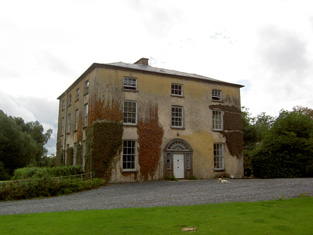
|
| Rockfield | A Nash home in the first half of the 19th century, occupied by Christopher Nash at the time of Griffith's Valuation and held from John James Nugent. The buildings were valued at £7. In the 1940s the Irish Tourist Association Survey noted that this property had once belonged to a family called Badham but was afterwards acquired by the Nashs and that "the present house was probably built by the latter family". A house and substantial farm are still extant at Rockfield. | |
| Ballyellis | Ballyellis was occupied by Edmund Barry in 1814 and by Henry Langley at the time of Griffith's Valuation. H. Langley held the property from James Barry and the buildings were valued at £12. It later came into the possession of the Harold Barry family and members of the family were still resident at Ballyellis at the beginning of the 21st century. |
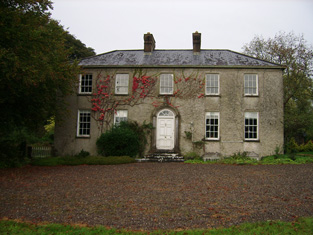
|
| Woodville | Built as a shooting lodge for the Holmes family, occupied by Richard Sherlock in 1814 and by Captain William Harrington Sherlock at the time of Griffith's Valuation and bought by him in the Encumbered Estates' Court. His daughter married George Washington Brasier Creagh and the house remained in her possession until the 1920s. It is now a Crofts residence. | |
| Ballyhoura Lodge | Ballyhoura Lodge was occupied by Christopher Crofts at the time of Griffith's Valuation. He held the property from the representatives of Robert Holmes and the buildings were valued at £23. The house is still a family home. |
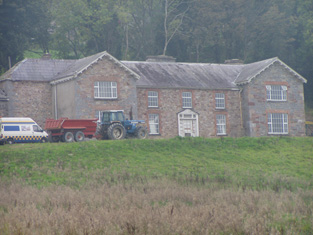
|
| Aughrim | A home of a branch of the Goold family occupied by George Goold in the early 1850s and held from Henry V. Wrixon. The buildings were valued at £13.10 shillings. George Goold still lived here in the 1870s. The house is occupied. | |
| Teeveeny House | A house valued at £14 held by Michael Cagney from Richard and Jonas Morris in the mid 19th century. His widow Johanna Cagney was still resident in the 1870s. In 1943 the Irish Tourist Association Survey reported that the house had was then occupied by the Condron family. Buildings are still extant at the site. | |
| Moyge | Richard Boles was granted Moyge in 1666. Sir Bernard Burke records the Boles of Devon as still having an interest in Moyge in 1850. At the time of Griffith's Valuation Maurice Newman [Nunan] was the occupier holding the property from the Earl of Bandon. The buildings were valued at £10. 10 shillings. This house no longer exists. | |
| Highfort | The Purcells originally lived in a thatched house located a short distance from the present building and this house was associated with a Whiteboy attack. John Purcell was knighted for his defense of his property. The later house was built by his son, Dr. Richard Purcell, circa 1837 and Dr Richard's wife, Mrs Eliza Purcell, was resident in the early 1850s when the house was valued at £21+ and held from Pierce Purcell. Mrs Eliza Purcell was the second daughter of Pierce Purcell of Altimira. Occupied by Daniel Stephen Wigmore in the early 20th century. The Irish Tourist Association Survey of the 1940s noted that it was then the residence of the O'Sullivan family. It is no longer extant. | |
| Newtown | The seat of the Knight family in the 18th century now demolished. Wilson refers to Newtown as the seat of Mr. Knight in 1786. This house was occupied by Michael Connor in the early 1850s, valued at £8 and held from Mrs Eliza Sealy. A later house now stands on the site. | |
| Curryglass | Originally a Goold home, occupied by B. Plummer in 1814 and Pierce Purcell Goold in 1837. His representatives held the property in fee at the time of Griffith's Valuation and the house was valued at £18. It was advertised for sale in May 1852. Home of Robert Edward Gibbings for sometime in the mid 19th century. An O'Callaghan home in the 20th century. Also known as Curraghglass or Curraglass House. In 1943 the Irish Tourist Association Survey noted its association with all of these families as well as, in the eighteenth century, the Lysaght family. It is still extant and occupied. |
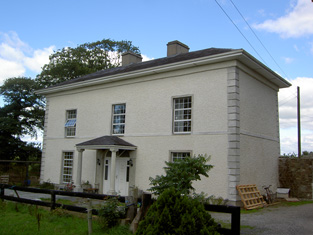
|
| Springfort | Dating from the very early 18th century, Springfort was the home of the Vowell family in the 18th century but Mr Cox is recorded as the proprietor in the late 1770s. By 1837 the Reverend Jonathan Bruce was resident. In the early 1850s William Carroll occupied the house holding the property from William Cox. The buildings were valued at £11+. This house was still extant in the 1980s when it was the home of the Cagneys. | |
| Farm Hill | In the mid 19th century occupied by Mrs Hannah Goold, valued at £13 and held from Richard and Jonas Morris. This house is marked on the first Ordnance Survey map and a building is still located at the site. | |
| Glenview Cottage | In 1786 Wilson refers to a house in the vicinity of Egmont as "Glenfield", the seat of Mr. Wrixon. This may be the property marked on the 1st edition Ordnance Survey map as Glenview Cottage. At the time of Griffith's Valuation, this house was leased by Daniel Murphy from the Egmont estate and valued at £10. A house is still extant at the site. | |
| Holmesfort | In the 1940s the Irish Tourist Association survey notes that a house at Shinanagh, parish of Imphrick, was occupied by Major Thomas Holmes in the early nineteenth century and known as Holmesfort. It was replaced in the 1830s by another house, built by an O'Connor family. By the 1940s it had become the home of the O'Regan family. A house and farm buildings are still extant at the site. |

